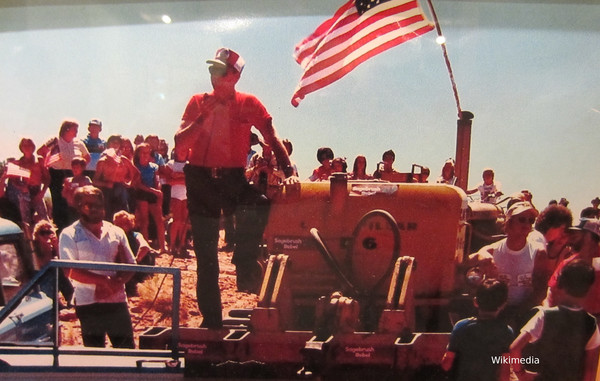Dublin Core
Title
Description
On July 4th, 1980 hundreds gathered near Grandstaff Canyon just outside of Moab, Utah to bulldoze a road into a Wilderness Study Area in violation of an order from the federal Bureau of Land Management, known as the BLM. These were not just any rabble-rousers. The Grand County Commission had approved the road, and several commissioners were present to symbolically declare independence from the BLM. One county commissioner claimed that bulldozing this road over public lands was (quote) “a matter of… freedom and liberty.” It was a day when long-simmering resentment of the federal government in rural Utah boiled over into action.
This demonstration was part of a larger movement emerging in the West known as the Sagebrush Rebellion. Protesters wanted the transfer of federal lands to the states and took aim at the supposed overreach of the federal government. Much of the rebellion took place in the halls of state houses, where six Western states – including Utah – debated bills demanding the so-called "return" of federal lands. But since the federal lands in question had never belonged to the states, such laws were political theater and doomed to fail challenges in court.
The BLM was the federal agency with the greatest direct impact on the lives of rural Westerners. So it was a natural target of ire for the Sagebrush Rebels. As state politicians investigated legal avenues for land transfers, the Rebellion adopted a militant tone on the ground. At a BLM public meeting further south in San Juan County, one commissioner there threatened to (quote) “start a revolution.”
The proposed Wilderness Study Area in Grandstaff Canyon near Moab would have restricted grazing and recreation in order to preserve the area’s ecology. Locals responded to the original proposal in 1979 with vandalism, and the BLM scaled down the study area dramatically. After the 1980 bulldozer incident, the BLM backed off again, temporarily removing the study area.
Later that year, Ronald Reagan won the US presidency. His sympathy for the Rebels and his appointment of James Watt to lead the Department of Interior quelled the protests -- for a time. Western politicians and rural residents still occasionally clamor for federal lands to be transferred to the states.
Creator
Source
_______________
See Craig Rayle, “July 4th Fireworks Misses Wilderness Study Area,” High Country News, July 11, 1980; James R. Skillen, This Land is My Land: Rebellion in the West (New York: Oxford, 2020); Moab District Staff Report, written by Janet Ross, April 11 and 12, 1979, Reel 1, Series 19269, Governor Matheson County Records, Utah State Archives and Records Service; Greg Smoak, Nate Housley, and Megan Weiss, Rural Utah at a Crossroads(Utah Humanities, 2023); Jonathan Thompson, “The First Sagebrush Rebellion: What Sparked It and How It Ended,” High Country News, January 14, 2016.

